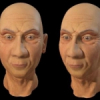Free Online Productivity Tools
i2Speak
i2Symbol
i2OCR
iTex2Img
iWeb2Print
iWeb2Shot
i2Type
iPdf2Split
iPdf2Merge
i2Bopomofo
i2Arabic
i2Style
i2Image
i2PDF
iLatex2Rtf
Sci2ools
IUI
2009
ACM
2009
ACM
Simplified facial animation control utilizing novel input devices: a comparative study
Editing facial expressions of virtual characters is quite a complex task. The face is made up of many muscles, which are partly activated concurrently. Virtual faces with human expressiveness are usually designed with a limited amount of facial regulators. Such regulators are derived from the facial muscle parts that are concurrently activated. Common tools for editing such facial expressions use slider-based interfaces where only a single input at a time is possible. Novel input devices, such as gamepads or data gloves, which allow parallel editing, could not only speed up editing, but also simplify the composition of new facial expressions. We created a virtual face with 23 facial controls and connected it with a slider-based GUI, a gamepad, and a data glove. We first conducted a survey with professional graphics designers to find out how the latter two new input devices would be received
in a commercial context. A second comparative study with 17 subjects was conducted to analyze...
| Added | 23 Jul 2010 |
| Updated | 13 Aug 2010 |
| Type | Conference |
| Year | 2009 |
| Where | IUI |
| Authors | Nikolaus Bee, Bernhard Falk, Elisabeth André |
Comments (0)





